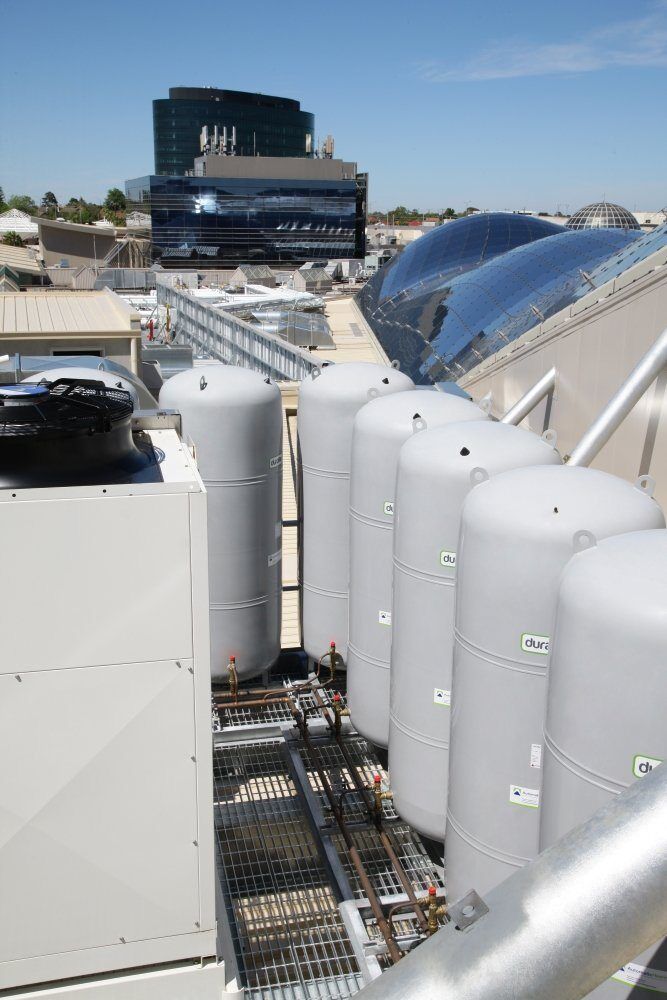Expansion Tanks Explained
Why do we need expansion tanks?
Expansion Tanks & Pressurisation systems are critical to the successful operation of heating and cooling circuits and must essentially fulfil three fundamental tasks:
- Maintaining the pressure within permissible limits at every point of the system, that is, the permissible working pressure must not be exceeded as well as maintaining a minimum pressure to prevent vacuum, cavitation and evaporation of the system liquid, e.g. in circuits with superheated water, solar systems.
- To prevent a negative pressure at the highest points of the installation in order to avoid the intrusion of air into the piping network.
- Compensation of volume fluctuations of the heating or cooling water due to temperature fluctuations.
- Providing a water seal to prevent system-related water losses.
With any heating or chilled water system there is expansion and contraction as the system water is heated or cooled. Because water is incompressible, the pressure in the system will increase or decrease accordingly. To prevent damage to the system components, expansion tanks are installed which contains the excess volume as the water heats and expands and allow that water to fill the vacuum created when the system water cools and contracts.
Careful calculation, commissioning and maintenance are the prerequisite for the correct functioning of the overall system.
Expansion tanks in open vs. closed systems
Open header or feed tanks were an early form of expansion tank which were usually copper lined open tanks installed above the highest point of the system as the tanks relied on gravity to maintain system pressure. Apart from the connection to the system, the tanks were fitted an overflow outlet and a mains water inlet controlled by a floating ball valve which allowed the system water to be replenished automatically if needed.
While functional, open header tanks fail to provide an optimal solution to the expansion problem due to several key issues.
- Because the tanks are unsealed, the system water is constantly exposed to the air which allows the system water to absorb oxygen. Oxygen in the system leads to corrosion and decreased pump efficiency.
- Depending on the design of the tank, there may be the potential for backflow if the water level rises above the mains inlet, leading to contamination of the water supply.
- With any open tank, there is the potential for overflow which is normally piped to the nearest drain. Given that the tank needs to be elevated, if the drain becomes blocked or the tank leaks, the resulting spillage may cause damage to surrounding building surfaces.
- Because the system is open, system pressure is limited to the head pressure achieved by the height of the tank. This may negatively impact pump performance due to insufficient NPSH (Net Positive Suction Head), potentially resulting in cavitation and pump failure.
- The pipe work run from the tank location to the plantroom can sometimes be arduous and may need insulating to protect against freezing in areas where sub-zero temperatures occur.
- Many modern boilers require controlled system pressures and water quality and are therefore not suited to open vented systems.
To overcome these issues, most heating and cooling systems are now designed as closed systems which allows system pressure to be controlled and gases to be eliminated, resulting in greater efficiencies and improved performance across all components of the system.
Expansion tanks for use in a closed heating or cooling system are available in various types and sizes. The type and size of tank used is usually governed by the intended application and can range from simple expansion tanks which are pre-charged and sized according to the design fill pressure and requirements of the system, through to pump controlled pressurization systems which may include degassing functions. The following article explains various types of expansion vessels, their features and the applications for which they are suited.
Next page – Types of Expansion Tanks
Expansion Tanks Overview

A quantity of 7 x DR800-3 Duraflex Forte 800L diaphragm type expansion vessels were installed to service the expansion requirements of the HHW Central Plant expansion system for Stage 40 upgrade of Melbourne’s iconic Chadstone Shopping Centre
